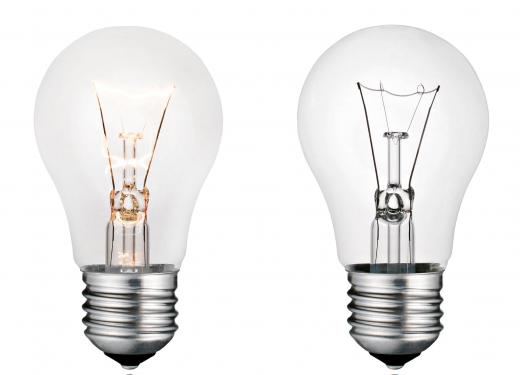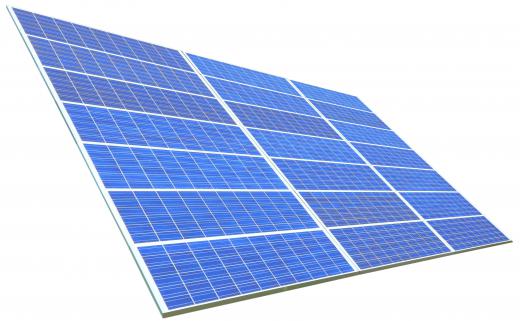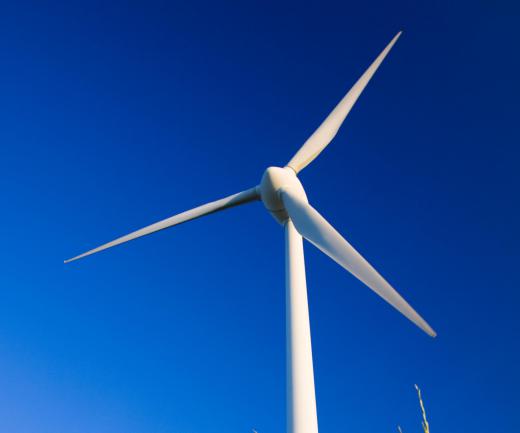What is Energy Transformation?
Energy transformation is the process of changing energy from one form to another. This process is happening all the time, both in the world and within people. When people consume food, the body utilizes the chemical energy in the bonds of the food and transforms it into mechanical energy, a new form of chemical energy, or thermal energy. Energy transformation is an important concept in the application of the physical sciences. The ability for energy to be transformed automates, lights, entertains, and warms the world in an astounding multitude of ways.
The concept of energy transformation can be illustrated in a number of common activities. An engine, such as the engine in a car, converts the chemical energy of gas and oxygen into the mechanical energy of engine movement. A light bulb changes the chemical energy of the bulb into electromagnetic radiation, or light. Windmills harness the energy of the wind and convert it into mechanical energy in the movement of the turbine blades, which is then converted to electrical energy. Solar panels transform light to electricity.

Energy transformation can also be explained in terms of potential energy, the stored energy of a system, which can be converted into kinetic energy, the energy of movement. For example, a roller coaster sitting at the top of a hill is said to have potential energy. This potential energy is gravitational, which is gained when the coaster moves up the hill. Once the coaster begins to move down the hill, the force of gravity is exerted and the potential energy is transformed into the kinetic energy of the car moving. During energy transformations, potential energy is often transformed to kinetic energy and back again to potential energy.

During any kind of energy transformation, some energy is lost to the environment. As a result of this loss, no machine is ever 100% efficient. Commonly, a portion of the energy lost during energy transformation is lost as heat. This can be observed in practice by noting the heat emitted by a computer, a car, or another type of machine that has been in use for a period of time.

The ability of a given machine or system to convert between forms of energy is called the "energy conversion efficiency." All systems have different energy conversion efficiencies. Water turbines, for instance, have an extremely high energy conversion efficiency of nearly 90%, while combustion engines have from 10% to 50% conversion efficiency. Engineering and physics are constantly in pursuit of systems capable of achieving high energy conversion efficiency.
AS FEATURED ON:
AS FEATURED ON:















Discussion Comments
What is energy transformation using wind energy?
I agree with post 67. You are responsible for ensuring the lecture material is correct. The lamp changes the applied electricity (ac or dc) into heat. Because the molecules of the lamp filament resist (but not stop) the flow of electrons, the filament molecules heat up to white hot and emit light and heat. Since to purpose of the lamp is to make light, the heat it produces is considered waste. This is in no way chemical energy transformed into light. Happy trails.
Last I checked, standard incandescent light bulbs do not use chemical energy to make the transformation to light. They use resistance within the filament, which is metal. No chemical change takes place.
Give examples showing heat is always released during energy transformation.
What is the transformation of geothermal energy to electrical energy?
What happens in an energy change?
What are the differences and similarities between energy transferred and energy transformed?
what are the other examples?
What are all forms of energy and examples of them?
As a beginning instructor on the topic of energy transformation, I think your explanations are great!
explain why this involves energy losses and why the proportion lost depends on the type of transformations, and the device or machine being used.
"During any kind of energy transformation, some energy is lost to the environment." That's also just the transformation of energy. You of course mean that it's not used by the human to reach a certain goal. But is the part of the energy that's
"used" by the human really for the benefit of humankind as a whole, since the use of energy by one human can lead to disprofit (up to death) for other humans - as the u.s. shows us on a daily basis?
About energy transformation: This means that you'd say that "potential energy" is equal to inner kinetic energy while the kinetic energy is equal to external kinetic energy.
Or, if you rather like to use potential energy, then kinetic energy is equal to inner potential energy while the thing you called potential energy before is external potential energy. You shouldn't use kinetic and potential energy at the same time. Of course you can.
You guys explain everything very well. just a few examples now and then.
what's the energy transformation of the work in a water engine to a light bulb?
There is definitely something about energy still to invent. If we can control the transformation from one type to another type of energy, we can chase the energy barriers and there won't be any requirement to extract fossil fuels.
As Einstein said, with 1 kg of sugar, we can run a car for 10 million kilometers, if we can use it's energy completely. But we could not do it now.
There is much scope to invent many things in energy. Since I am a commerce graduate, I could not dig into it much. But the physics and chemistry guys can dig in depth.
What is the energy transformation in burning firewood?
What is conversation energy?
why is energy transformation important?
what is an example of energy transformation? -Scientist at Heart
ah OK i understand now what is energy transformation. thanks for that, researchers.
what are the energy transforms in:
microwave, digital clock, steam iron, ceiling fan and stove?
There are really only two types of energy: kinetic (the energy of motion) and potential (stored energy), everything else are really subclasses. Chemical energy is potential, the energy stored in the chemical bonds. The transformation is the interaction between particles (sometimes subatomic particles) and intermolecular (or intramolecular) forces. After that it is more complex.
how does the transformation work?
Nicely explained. Although I'm confuzzled about the chemical transformation and how it relates to neuro sciences. Please answer my confuzzlement?!
there should be more on heat energy and all of the other energies as well.
can i please have a better explanation of chemical energy transformation?
Could I have more examples of energy transformation?
wonderful explanation.
What are all forms of energy and examples of them?
Post your comments